Abstract
Graded concentrations of dietary T-2 toxin (0, 1, 2, 4, 8, and 16 μg/g) were fed to groups of 40 chickens. T-2 toxin was found to cause an abnormal positioning of the wings, hysteroid seizures, and impaired righting reflex in young chickens. The abnormal wing positioning occurred spontaneously or as the result of dropping from a height of 1 meter. The seizures could be elicited by rough handling or loud noises. The seizures and the abnormal wing posture would not occur again when the stimulus was repeated unless a rest period of 3 to 6 h was allowed. The loss of righting reflex could be demonstrated at any time. The total incidence of neural symptoms was dependent on the length of exposure to T-2 toxin and to its concentration. Neural toxicity occurred at dosages of 4, 8, and 16 μg per g of diet, which are the same doses that retard growth. This neural toxicity of T-2 toxin in chickens is similar to the neural disturbances associated with alimentary toxic aleukia, a nutritional toxicosis of humans produced by eating moldy grain. T-2 toxin has been implicated also in moldy corn toxicosis which has neural manifestations in horses and swine.
Full text
PDF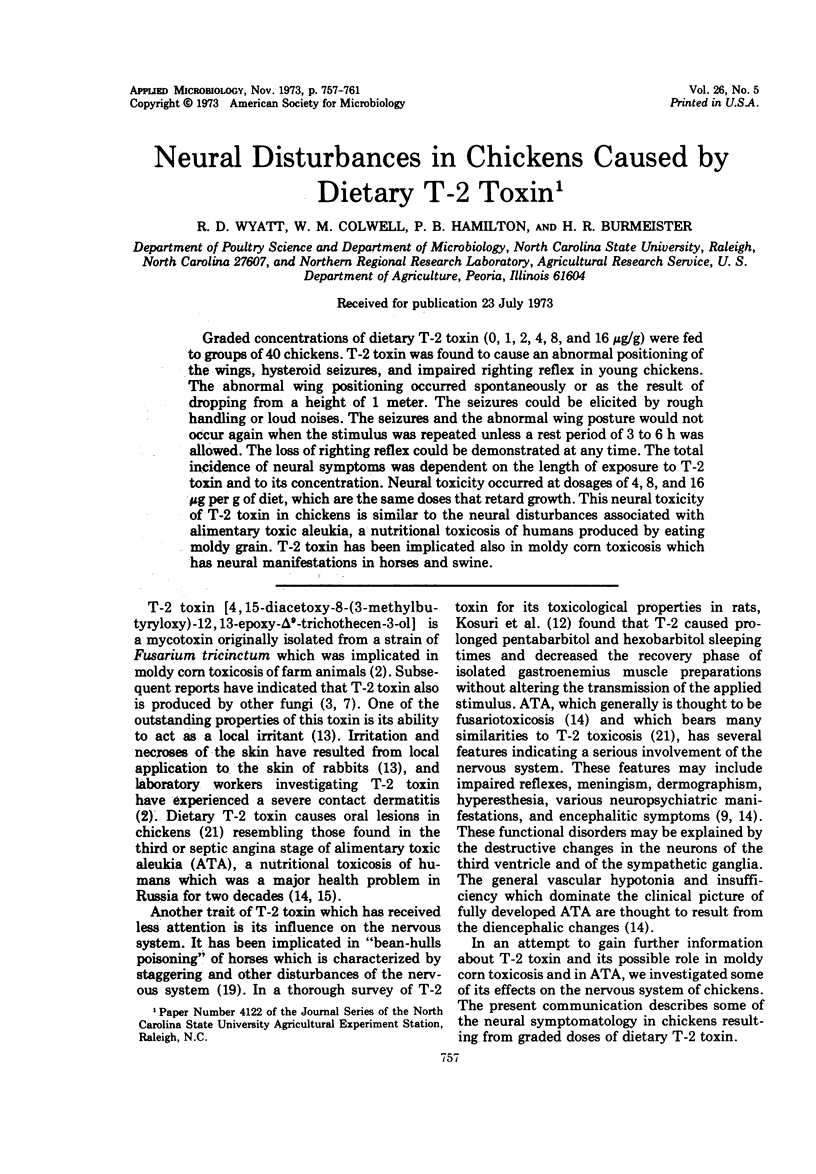
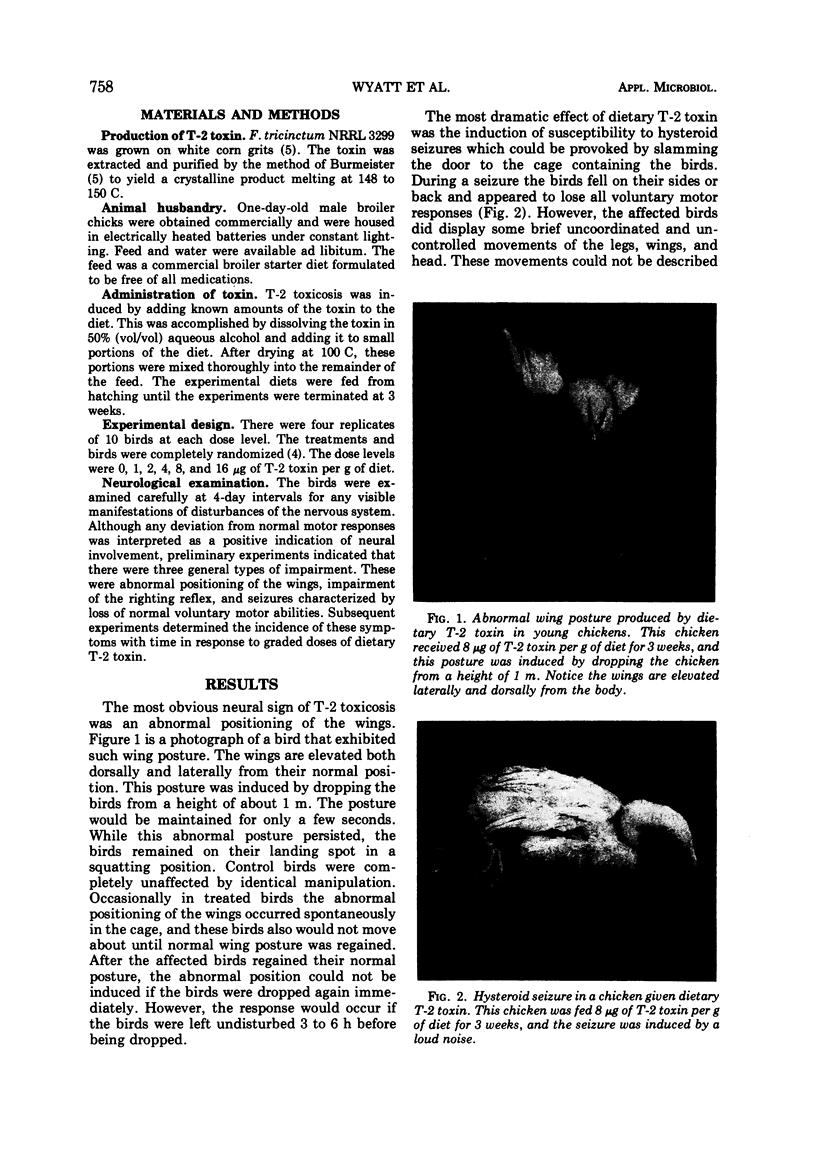
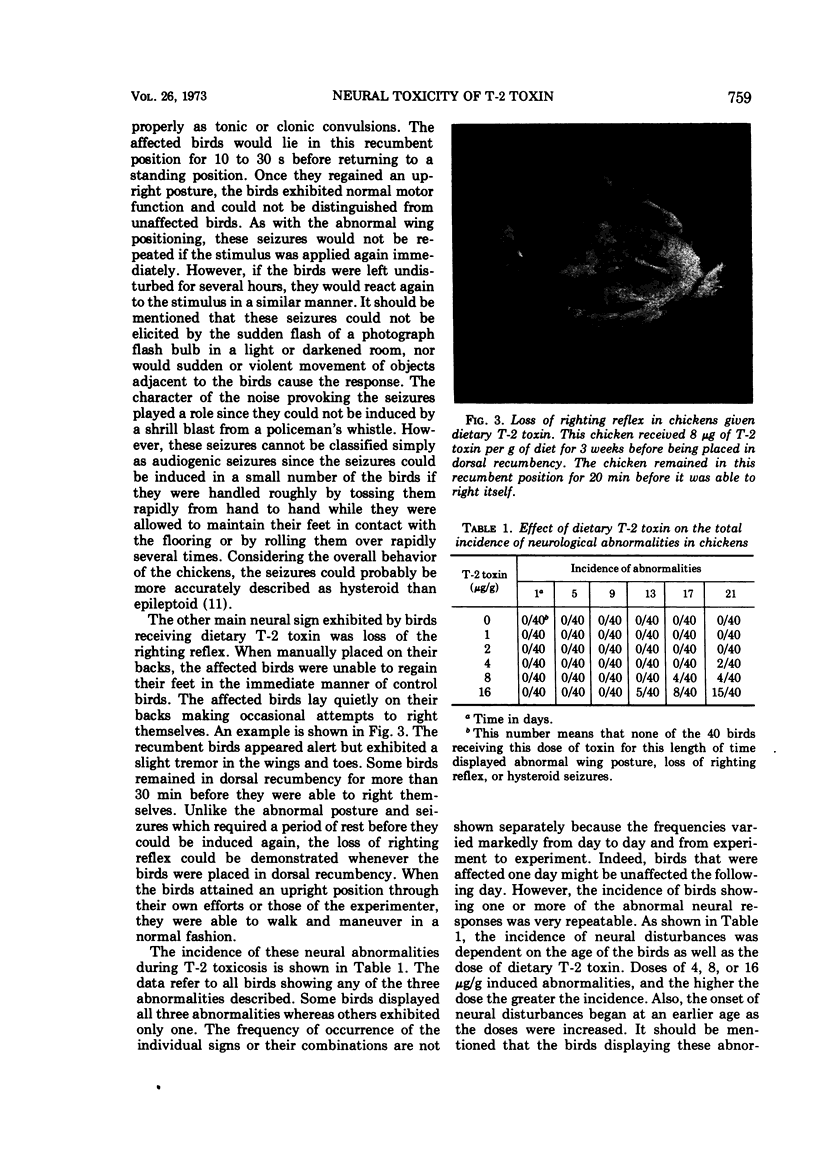
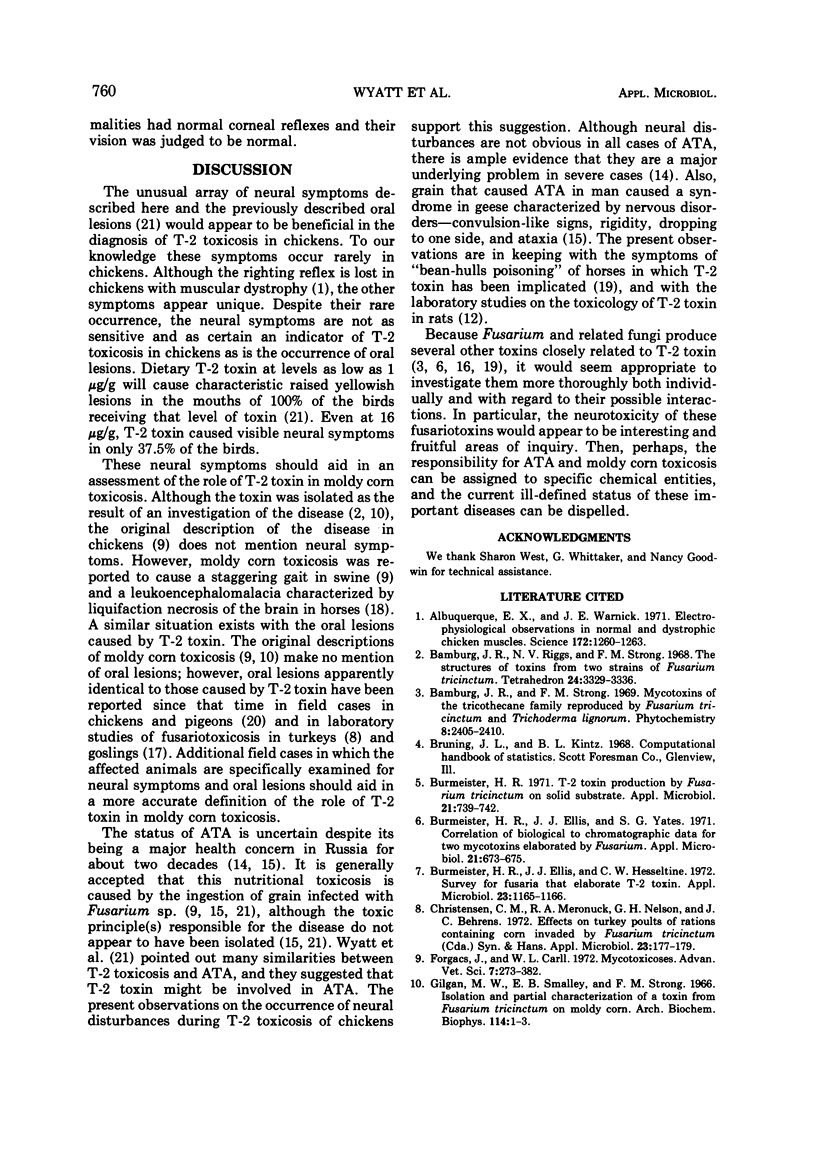
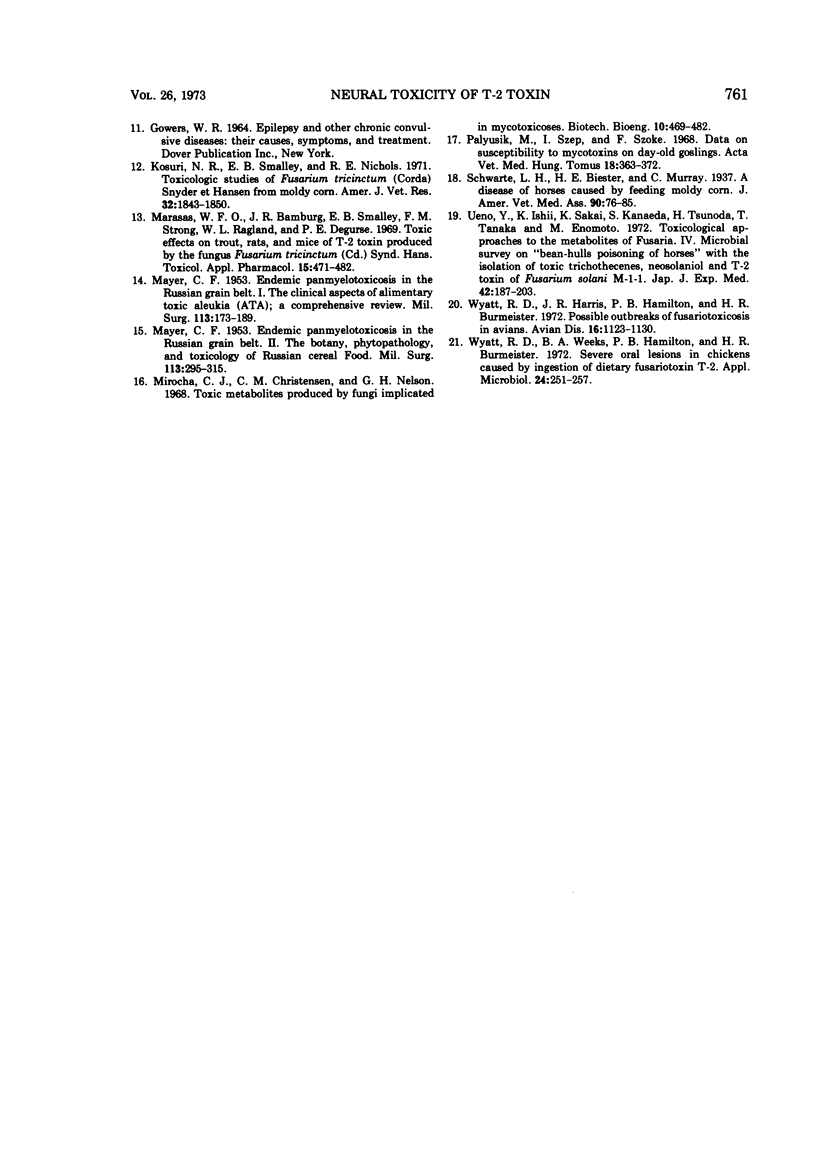
Images in this article
Selected References
These references are in PubMed. This may not be the complete list of references from this article.
- Albuquerque E. X., Warnick J. E. Electrophysiological observations in normal and dystrophic chicken muscles. Science. 1971 Jun 18;172(3989):1260–1263. doi: 10.1126/science.172.3989.1260. [DOI] [PubMed] [Google Scholar]
- Bamburg J. R., Riggs N. V., Strong F. M. The structures of toxins from two strains of Fusarium tricinctum. Tetrahedron. 1968 Apr;24(8):3329–3336. doi: 10.1016/s0040-4020(01)92631-6. [DOI] [PubMed] [Google Scholar]
- Burmeister H. R., Ellis J. J., Hesseltine C. W. Survey for fusaria that elaborate T-2 toxin. Appl Microbiol. 1972 Jun;23(6):1165–1166. doi: 10.1128/am.23.6.1165-1166.1972. [DOI] [PMC free article] [PubMed] [Google Scholar]
- Burmeister H. R., Ellis J. J., Yates S. G. Correlation of biological to chromatographic data for two mycotoxins elaborated by Fusarium. Appl Microbiol. 1971 Apr;21(4):673–675. doi: 10.1128/am.21.4.673-675.1971. [DOI] [PMC free article] [PubMed] [Google Scholar]
- Burmeister H. R. T-2 toxin production by Fusarium tricinctum on solid substrate. Appl Microbiol. 1971 Apr;21(4):739–742. doi: 10.1128/am.21.4.739-742.1971. [DOI] [PMC free article] [PubMed] [Google Scholar]
- Christensen C. M., Meronuck R. A., Nelson G. H., Behrens J. C. Effects on turkey poults of rations containing corn invaded by Fusarium tricinctum (Cda.) Sny. & Hans. Appl Microbiol. 1972 Jan;23(1):177–179. doi: 10.1128/am.23.1.177-179.1972. [DOI] [PMC free article] [PubMed] [Google Scholar]
- Gilgan M. W., Smalley E. B., Strong F. M. Isolation and partial characterization of a toxin from Fusarium tricinctum on moldy corn. Arch Biochem Biophys. 1966 Apr;114(1):1–3. doi: 10.1016/0003-9861(66)90297-9. [DOI] [PubMed] [Google Scholar]
- Kosuri N. R., Smalley E. B., Nichols R. E. Toxicologic studies of Fusarium tricinctum (Corda) Snyder et Hansen from moldy corn. Am J Vet Res. 1971 Nov;32(11):1843–1850. [PubMed] [Google Scholar]
- MAYER C. F. Endemic panmyelotoxicosis in the Russian grain belt. I. The clinical aspects of alimentary toxic aleukia (ATA); a comprehensive review. Mil Surg. 1953 Sep;113(3):173–189. [PubMed] [Google Scholar]
- MAYER C. F. Endemic panmyelotoxicosis in the Russian grain belt. II. The botany, phytopathology, and toxicology of Russian cereal food. Mil Surg. 1953 Oct;113(4):295–315. [PubMed] [Google Scholar]
- Marasas W. F., Bamburg J. R., Smalley E. B., Strong F. M., Ragland W. L., Degurse P. E. Toxic effects on trout, rats, and mice of T-2 toxin produced by the fungus Fusarium tricinctum (Cd.) Snyd. et Hans. Toxicol Appl Pharmacol. 1969 Sep;15(2):471–482. doi: 10.1016/0041-008x(69)90045-3. [DOI] [PubMed] [Google Scholar]
- Palyusik M., Szép I., Szöke F. Data on susceptibility to mycotoxins of day-old goslings. Acta Vet Acad Sci Hung. 1968;18(4):363–372. [PubMed] [Google Scholar]
- Ueno Y., Ishii K., Sakai K., Kanaeda S., Tsunoda H. Toxicological approaches to the metabolites of Fusaria. IV. Microbial survey on "bean-hulls poisoning of horses" with the isolation of toxic trichothecenes, neosolaniol and T-2 toxin of Fusarium solani M-1-1. Jpn J Exp Med. 1972 Jun;42(3):187–203. [PubMed] [Google Scholar]
- Wyatt R. D., Harris J. R., Hamilton P. B., Burmeister H. R. Possible outbreaks of fusariotoxicosis in avians. Avian Dis. 1972 Oct-Dec;16(5):1123–1130. [PubMed] [Google Scholar]
- Wyatt R. D., Weeks B. A., Hamilton P. B., Burmeister H. R. Severe oral lesions in chickens caused by ingestion of dietary fusariotoxin T-2. Appl Microbiol. 1972 Aug;24(2):251–257. doi: 10.1128/am.24.2.251-257.1972. [DOI] [PMC free article] [PubMed] [Google Scholar]





